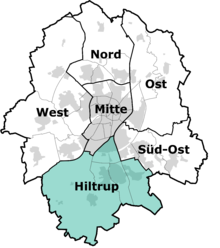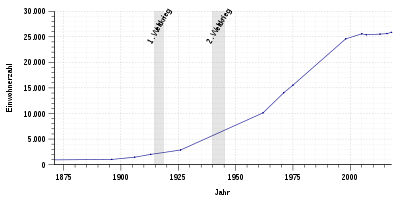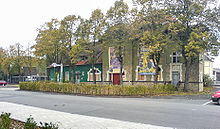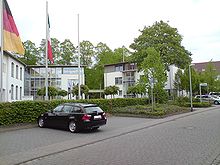Hiltrup
|
Hiltrup
City of Munster
|
|
|---|---|
| Coordinates: 51 ° 54 ′ 10 ″ N , 7 ° 38 ′ 20 ″ E | |
| Height : | 65 m |
| Area : | 21.63 km² |
| Residents : | 25,869 (December 31, 2017) [1] |
| Population density : | 1,196 inhabitants / km² |
| Incorporation : | 1st January 1975 |
| Postal code : | 48165 |
| Area code : | 02501 |
Hiltrup is one of the suburbs and, as "Münster-Hiltrup", is the 9th district of the independent city of Münster in Westphalia, and with around 25,000 inhabitants, the largest district. The formerly independent place was incorporated into Münster on January 1, 1975 as part of the municipal reform. There is also a district of the same name, which, in addition to Hiltrup, includes the districts of Berg Fidel / Vennheide and Amelsbüren (with the farmers' associations Sudhoff, Loevelingloh and Wilbrenning).
Location / townscape
Hiltrup is about 6.5 kilometers south of the city center of Münster. It borders (clockwise, starting in the southwest) on Amelsbüren , Vennheide , Gremmendorf , Angelmodde (all to Munster), Albersloh (to the city of Sendenhorst ) and Rinkerode (to the city of Drensteinfurt ).
The townscape is shaped by the Dortmund-Ems Canal and the industrial plants of BASF Coatings (formerly Glasurit ) and the Rockwool plant, which was closed in 2002 (Basalan-Isolierwolle GmbH until 1985), whose tall chimney still exists today. Since many working commuters live in Hiltrup who arrive and depart daily by car, and the town has a central location for through traffic due to the B 54 and the road connections to Amelsbüren, Wolbeck and Angelmodde, there are some roads here at rush hour high traffic. There are numerous agriculturally used areas as well as extensive forest areas around the built-up interior of Hiltrup.
Hiltrup can be found in the districts of Hiltrup West (west of Westfalenstraße / B54 to Amelsbüren), Hiltrup Mitte (called 'Dorf' by locals) between Westfalenstraße and Dortmund-Ems Canal and Hiltrup Ost (from Dortmund-Ems Canal to Albersloher Weg) and Hiltrup Nord. The south-western area of Hiltrup-Ost is also known as the Emmerbachtal because of the stream that runs there .
history
The first traces of settlement in Hiltrup can be traced back to the time around the birth of Christ. At that time the Germanic tribe of the Brukterer lived in the Münsterland . Traces of posts and a hearth found on the channel island of the Dortmund-Ems canal in the south of the district are evidence of this.

The first settlement did not emerge until 1160 with the construction of the Romanesque church of St. Clemens on today's Westfalenstrasse . The name Hiltrup is documented for the first time in 1233.
The first school in Hiltrup was opened in 1733, followed by a girls' school in 1890. The town was connected to the railroad in 1848 when the Münster-Hammer Eisenbahn-Gesellschaft completed the construction of the Münster – Hamm railway line . The opening was celebrated on May 26th at the train station “Diecke Wief” (“Dickes Weib”), named after the nearby restaurant “Dicke Wieve”. On August 1, 1868, the station was relocated and the new Hiltrup station opened.
Hiltrup received the first volunteer fire brigade in 1892 when the Hiltrup volunteer fire brigade was founded . In 1894, Father Hubert Linckens of the Sacred Heart of Jesus founded a mission monastery on the Red Mountain , which was inaugurated on December 8, 1897. A corresponding women's order was founded on March 25, 1900; The " Missionary Sisters of the Sacred Heart of Jesus von Hiltrup " founded the Sacred Heart Hospital in 1950 .
On August 11, 1899, Hiltrup received another traffic connection with the opening of the Dortmund-Ems Canal . Four years later, Max Winkelmann set up a Glasurit branch in Hiltrup, which later became the headquarters and, after being sold to BASF in 1975 and renamed BASF Coatings , one of the most important paint manufacturers in the world. Other important structures erected before the First World War include the Hohe Ward waterworks in 1905 and the large Clemenskirche, consecrated in 1913 on today's Marktallee . As a result of the further expansion of the railroad and the sand required to fill the embankments , the Steiner See , named after its first tenant, was created in the south of Hiltrup , today a local recreation area under the name Hiltruper See .
The first significant company founded after the end of the First World War was the founding of the Hiltrup sand-lime brick factory by Leo Schencking in 1928. The Münster Agricultural Publishing House, founded two years earlier, was to move into his villa in 1948 . Another important building was the construction of the first Protestant church on the Hohe Geest in 1932.
After the end of the Second World War , the Police Command Academy was opened in July 1945 . Partly housed in a quarter built in the mid-1930s of a unit of motorized rural gendarmerie, which since March 1, 2006 has been renamed the German Police University under a changed statute .
In 1956 the Catholic Church of St. Mary was consecrated . In 1970, the Christ Church on Hülsebrockstrasse, the second Protestant church in Hiltrup, was inaugurated. Two years later, the "Hohe Ward forest cemetery" was consecrated.
In 1965, Hiltrup received its official coat of arms: a red anchor and a red sun wheel on a yellow background. In the 1970s, the town twinning with Beaugency in France began in 1974 ; on the other hand, Hiltrup lost its independence on January 1, 1975 as part of the regional reform in North Rhine-Westphalia and was incorporated into the city of Münster. In 1980 the Hiltrup city hall was completed. In addition to the Halle Münsterland, it is a venue for larger events in Münster. Four years later, on September 1, 1984, the Hiltrup Museum opened in the old steam mill. With the expansion of the Dortmund-Ems Canal at the turn of the millennium, the new canal bridges were also necessary. Against this background, in 2001 the world's largest arched bar railway bridge for the Münster – Hamm railway line was floated in.
In 2002 the Rockwool works, one of the most important employers in Hiltrup, were closed. The last shift ended on June 12, 2002. In 2003, Bait ul-Mo'min , the first mosque in Münster, opened . Since March 1, 2006, Hiltrup has had its own university, the German Police University. It emerged from the former police leadership academy by resolution of the North Rhine-Westphalian state parliament.
| Population development ¹ census result | ||||||||||
| year | population | year | population | year | population | year | population | |||
| 1160 | 80 | 1895 | 1,013 | 1961 | 10.137 | 2004 | 25,592 | |||
| 1517 | 100 | 1905 | 1,447 | 1970 | 14.052 | 2006 | 25,402 | |||
| 1668 | 193 | 1912 | 2.010 | 1974 | 15,536 | 2012 | 25,534 | |||
| 1750 | 535 | 1925 | 2,861 | 1997 | 24,604 | 2015 | 25,623 | |||
| 1865 | 665 | 1950 | 7,348 | 2000 | 25,428 | 2017 | 25,869 | |||
coat of arms
Blazon : "In gold (yellow) a sloping red anchor, in the left upper corner a red sun wheel with silver (white) spokes." The coat of arms awarded by the Minister of the Interior of North Rhine-Westphalia in 1965 shows a double meaning next to the anchor - as an attribute of the Pope Klemens, patron of the local church and as a symbol for the canal port on the Dortmund-Ems canal, the sun wheel as a talking symbol, based on the name of the medieval noble family Sonnborn, which had a great influence in Hiltrup. The colors come from the coat of arms of the bishopric of Münster.
Economy and Infrastructure
traffic
Hiltrup is of the national road 54 traverses and is attached via the motorway junction Münster-Hiltrup A 1 connected. Hiltrup has its own train station on the Münster – Hamm line operated by DB Netz AG . The freight yard has been closed after BASF has now carried out its transports by road. The Dortmund-Ems Canal, which cuts through the entire town, offers yacht and boat captains good mooring opportunities for a flying visit, especially in the area of the Alte Fahrt. In Hiltrup-Ost there is an official take-off / landing site for hot air balloons right on the canal . Hiltrup is connected to Münster and the surrounding area with 4 city buses (lines 1, 5, 6, & 9), 2 night buses (lines N81 & N82), 1 minibus (line 18) and 2 regional bus lines (lines 341 & 342) .
Established businesses
The largest company and the largest local employer with around 2,300 employees is BASF Coatings GmbH, a manufacturer of paints. The company is known in Hiltrup under the current trade name Glasurit , which it had as the company name before it was taken over by BASF in 1965.
Hiltrup is also the headquarters of the Münster Agricultural Publishing House . The Waldhotel Krautkrämer, located south of the canal on Lake Hiltrup, is also well-known and regularly hosts well-known personalities. Among other things, the Dutch national football team around Johan Cruyff lived here during the 1974 World Cup ; At the 2006 World Cup , the hotel was on the official FIFA recommendation list , but was not booked by any national football association.
Public facilities
The Sacred Heart Hospital, supported by the Missionary Sisters of the Sacred Heart of Jesus , is located in Hiltrup . On November 15, 2017, the hospital was sponsored by the St. Franziskus Foundation in Münster.
To the west of Westfalenstrasse ( Bundesstrasse 54 ) just before the border with the Warendorf district is the former Heidhorn estate , which has existed since at least the 13th century. Nowadays, an old people's home of the Alexians and the NABU nature conservation station Münsterland are located here.
Construction of the Hiltrup town hall began shortly before it was incorporated into Münster in 1975; With around 75,000 visitors per year, it is an important event hall in the city. Hiltrup also has a district library, an information point, a police station and a fire station .
In the sports and leisure area, there is an indoor pool and an outdoor pool between the canal and Hiltruper See, which is popular with the population . As part of the restructuring of the Münster bathing landscape, the Hiltrup outdoor swimming pool was modernized in 2008 and converted into a leisure-oriented swimming pool.
The Hiltrup district administration is located on Patronatsstraße in Hiltrup Mitte as a branch of the municipal office for citizens' affairs with a job center and social welfare office. The Hiltrup police station, which was newly built in the 1990s and serves the southern part of the city as part of the Münster police force, is located nearby.
education
There are two grammar schools in Hiltrup, each with a secondary, secondary and special school and four primary schools. The catchment area of the municipal Immanuel-Kant-Gymnasium and the episcopal Kardinal-von-Galen-Gymnasium includes not only the southern part of Münster but also the neighboring communities, in particular Drensteinfurt. A total of around 4,500 students attend the Hiltrup schools.
The German Police University, where the police executives are trained, has nationwide importance , making Hiltrup the location of a scientific university. Also worth mentioning is the Westphalian School for Music, which offers events on site, as well as the Central School for Health Professions St. Hildegard GbR, which is housed in the Sacred Heart Hospital.
religion
As in the rest of the city of Munster, the majority of Hiltrup residents are Roman Catholic. There are two Catholic parishes, St. Clemens in Hiltrup-Mitte and St. Marien in Hiltrup-Ost, which together with St. Sebastian Amelsbüren form a pastoral community. In addition to the parish church of St. Clemens located on Marktallee / Hohen Geest, there is still the Old Clemens Church from 1160, where services are also held.
The Christ Church of the Protestant Christ Congregation is located on Hülsebrockstraße , which together with the Protestant congregation in Amelsbüren (Kreuz-Christi congregation) forms a church district. It is noteworthy that there is a used bell tower in front of the Christ Church, which was bought by another parish with donations for cost reasons. The entire bell tower was dismantled in Werdohl in the Sauerland, 100 km away , transported to Hiltrup and consecrated there in September 2006.
There is also a church building for the New Apostolic congregation on Bockhorststrasse. The community center of the Evangelical Church Community of Münster is also located in Hiltrup. The local Old Catholics belong to the Münster community and do not have their own building in Hiltrup.
In 2003 the Bait ul-Momin (House of Believers) of the Ahmadiyya Muslim Jamaat was opened as the first new mosque in Münster. A demonstration by right-wing circles took place in front of this building in 2012, and the mosque had to be protected by a strong police force.
Culture
In terms of culture, the district has its very own world, separated from the Münster regional center: many groups - often committed to specific countries - create a colorful variety of folklore, music, handicrafts and creativity. In addition to these mostly association-related activities, the independent group “Kulturinitiative Hiltrup” was formed in 2002, which until its dissolution in January 2009 organized completely voluntary unusual activities (motto “unexpected”) in and for the district several times a year. Motivated by their success, there are now many other groups - often with a commercial background - who organize further activities for the public at different distances and in different sizes. Mostly these are loose connections and collaborations between associations and companies that come together on a case-by-case basis. There are also some other official bodies and institutions.
The Hiltrup town hall offers many concerts and cultural events (“Hiltrup highlights”) with often well-known artists.
The local business association Hiltrup is now establishing its events as well-known throughout the city and fixed events in the event calendar (spring festival with the town center closed, bike races "around the market avenue", festival of lights, etc.).
In the former Hiltruper fire station now houses the Hiltruper Museum . The museum presents the history of Hiltrup, its associations and institutions with changing focuses and is open to cultural events and lectures.
The Schnake art gallery and various galleries and studios cover the range of art and culture on offer from a commercial point of view.
Since August 2014, the Hiltrup station building has been available to the citizens as the Hiltrup cultural station . The Hiltrup e. V. has created new space for culture, exhibitions and celebrations in Hiltrup from the old station building.
youth
There are numerous sports clubs, community youths and scout associations in Hiltrup. The two scout associations based in Hiltrup, the DPSG (Rochus Spiecker) and the VCP (Stamm David) are enjoying great popularity. The young people also have the opportunity to spend their free time in one of the three youth centers (37 ° degrees, ev. Youth center and St. Clemens youth home). All in all, the possibilities of youthful life in Hiltrup are very diverse and are well received.
Borough
The Münster-Hiltrup district is located in the south of the city of Münster and borders on the West , Central and South-East districts . It covers an area of 69.86 km² with a population of 37,399 inhabitants (as of December 31, 2011). In addition to Hiltrup-Ost, Hiltrup-Mitte and Hiltrup-West, the district of Hiltrup also includes the residential areas (districts) Amelsbüren and Berg Fidel / Vennheide.
Districts of Münster-Hiltrup (9)
- 91 Mount Fidel
- 95 Hiltrup-Ost
- 96 Hiltrup-Mitte
- 97 Hiltrup-West
- 98 Amelsbueren
politics
Since the 2014 local elections , the Münster-Hiltrup district council has 19 members in the current legislative period , who are distributed among the individual parties as follows:
The district mayor is currently Joachim Schmidt (CDU). His deputies are Dieter Langer (SPD), Ulrich Eckervogt (FDP) and Wilfried Stein (GREEN).
Individual evidence
- ^ Federal Statistical Office (ed.): Historical municipality directory for the Federal Republic of Germany. Name, border and key number changes in municipalities, counties and administrative districts from May 27, 1970 to December 31, 1982 . W. Kohlhammer, Stuttgart / Mainz 1983, ISBN 3-17-003263-1 , p. 311 .
literature
- Jost Auler , Münster-Hiltrup in prehistoric and early history. An archaeological survey of the area (Charybdis vol. 6). Münster / Hamburg 1993.
- Werner Dobelmann , Hiltrup, Münster in Westphalia 1974.
Web links
- Official website of the city of Münster for the Hiltrup district
- District website of the Hiltrup eV district offensive
- Information platform for the district
- Official website of the city of Münster on the election results in the Hiltrup district
- Official website of the city of Münster for the Hiltrup district representation
- Hiltrup in the Westphalia Culture Atlas










